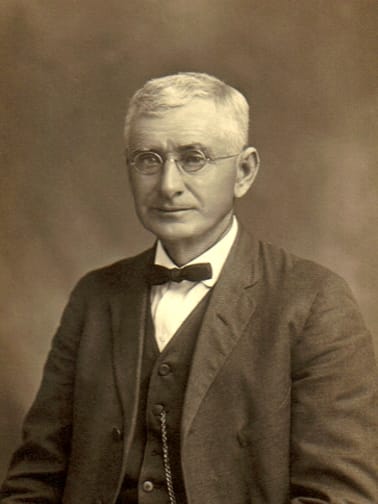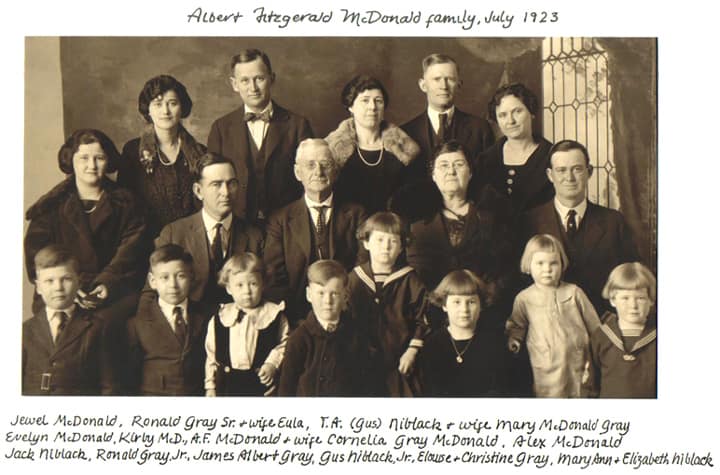The Abilene Christian University community bid a fond farewell to McDonald Hall in mid-June. The residence hall – one of the original buildings of our hilltop campus, opened in 1929 – was demolished and will be replaced by a new one.
McDonald was named for Albert “A.F.” McDonald and his wife, Cornelia Elizabeth “Neelie” (Gray) McDonald, two of the original benefactors for the university, which began as Childers Classical Institute in September 1906 on North First Street in Abilene. A.F. was one of the five founding trustees, serving until his death in 1924.
“The McDonald family is one of our founding families, and we are so grateful for the legacy they built here and their firm belief in the need for Christian higher education,” said Jim Orr, J.D. (’86), vice president for advancement. “Generations of McDonalds have been a part of our community, and we will continue to honor them in multiple ways, including within the new residence hall.”
Enlarge

A.F. hailed from Alabama (born 1859), while Cornelia was born in North Carolina in 1869. They moved from Wills Point, Texas, to a farm near Buffalo Gap, south of Abilene, in 1889, with son Kirby, around age 2, and daughter Mary, still a baby. Cornelia was one of eight children and had dropped out of school at age 15 when her father, Eli Gray, died of pneumonia. She married A.F. at age 18.
“It was not so hard for papa to move west, but mother was barely 20 and had never been separated long from her invalid and widowed mother,” said daughter Mary (McDonald ’12) Niblack in Like Stars Shining Brightly, a history of the university authored in 1953 by Dr. Max Leach (’31) and Dr. Don H. Morris (’24), ACU’s eighth president. “But papa and mama were happy and found two other families in nearby Buffalo Gap with whom they visited and worshipped God on the Lord’s Day.”
In 1890, A.F. bought 160 acres of land in west Abilene along Catclaw Creek and the Texas and Pacific Railroad, and soon the family moved to town, living on South First Street. A.F. and Cornelia’s family eventually grew to include son Alex and daughters Eula, Dorothy Jewel, Evelyn, and Edith, who died as a child. The McDonalds and other families – including Billingsley, Childers, Meyers, Roberts and Harvey – formed the Abilene Church of Christ, now the University Church of Christ.
A.B. Barret, ACU’s first president, found like minds in that small congregation when he came to Abilene in 1905 with the idea to build a Christian school. Barret is reported to have said that “among their number there were some wide awake men,” and he mentioned McDonald, Henry Free and Col. John W. Childers. They were all enthusiastic about the school and were instrumental in making it a reality.
What certainly helped is that the church was quickly outgrowing its meeting place on Chestnut on property owned by Childers, one of its elders. He also owned about five acres of land on North First Street, with his home in its middle. In selling that property to the school, Childers made sure to arrange for a permanent meeting place for the congregation on campus.
As Barret fundraised for the school, others did their part to build interest, with A.F. asking local farmers and ranchers to move to Abilene so there would be enough children to attend. Classes began Sept. 11, 1906, and several of the McDonald children would attend throughout the coming years, including Mary, William Alex (’10), Jewel Dorothy (McDonald ’24) Martin and Evelyn (McDonald ’28) Pruitt, who was a member of what is now the GATA women’s social club. Mary taught on the faculty in the early 1910s, teaching Latin and Expression. Descendants of Mary through one of her daughters, Roberta (McDonald ’49) Brockman, have attended ACU as recently as the 2000s: Donald Brockman (’04) and Benjamin Brockman (’05), two of Roberta’s grandchildren.
A few years later, when financial troubles hit the school, A.F. raised funds on its behalf. Soon, he sold most of his land along Catclaw and the railroad – an amount of $12,000 (more than $300,000 in today’s money), the largest gift to the institution during its first half-dozen years, according to No Ordinary University by Dr. John C. Stevens (’38), ACU’s ninth president. Morris referred to the gift in 1973, saying it “saved the college.” The McDonald family moved to Lubbock in 1914, where A.F. operated the McDonald Livery Stable.
In Fall 1924, a new men’s residence hall was to open on the North First Street campus. “However, just a month before the new dormitory was scheduled to open, the man died who, more than any other person, had been responsible for establishing, or reviving, the Church of Christ in Abilene, and who led the way in receiving A.B. Barret encouraged him to start a school. He was Albert Fitzgerald McDonald,” wrote Stevens in No Ordinary University. The trustees voted unanimously to name it McDonald Hall.
When the new campus opened in September 1929, the name followed: McDonald Hall, at a cost of $106,956.59, was one of its original structures, along with the Administration Building, Zona Luce Education Building, Zellner Hall and Chambers Hall. Bennett Gymnasium and Sewell Auditorium followed in 1930.
The men’s hall was converted to a women’s hall in 1942 as World War II changed the demographics on campus, and it was used as such through May 2018.
When Cornelia died in Lubbock in 1961 at age 92, her survivors included four (of seven) children, 22 grandchildren, 43 great-grandchildren and two great-great-grandchildren.
Stevens preached her funeral service, held at Broadway Church of Christ.

